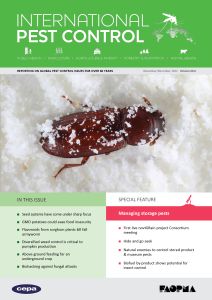The Basic Principles Of Eco Bed Bug Exterminators Dc
The Basic Principles Of Eco Bed Bug Exterminators Dc
Blog Article
Excitement About Eco Bed Bug Exterminators Dc
Table of ContentsSome Of Eco Bed Bug Exterminators DcThe Best Guide To Eco Bed Bug Exterminators DcThings about Eco Bed Bug Exterminators DcThe Definitive Guide for Eco Bed Bug Exterminators Dc7 Simple Techniques For Eco Bed Bug Exterminators Dc
Due to the fact that chemicals are poisonous, they are also possibly dangerous to human beings, animals, other organisms, and the environment. People who make use of pesticides or consistently come in contact with them must comprehend the relative toxicity, potential wellness effects, and preventative steps to lower direct exposure to the products they use. Hazard, or threat, of using chemicals is the capacity for injury, or the level of danger involved in using a pesticide under a given collection of problems.
Applicators can decrease or nearly eliminate exposure-- and hence minimize danger-- by adhering to the tag directions, making use of personal safety apparel and tools (PPE), and taking care of the pesticide properly. More than 95 percent of all chemical exposures come from facial exposure, mostly to the hands and forearms. By wearing a set of unlined, chemical-resistant gloves, this type of exposure can be almost removed.
The unsafe results that occur from a single exposure by any course of access are described "severe impacts." The 4 routes of exposure are facial (skin), breathing (lungs), oral (mouth), and the eyes. Acute toxicity is figured out by taking a look at the dermal poisoning, breathing poisoning, and dental poisoning of examination animals.
All about Eco Bed Bug Exterminators Dc
Acute toxicity is measured as the quantity or concentration of a toxicant-- the a.i.-- called for to eliminate 50 percent of the animals in a test population. This action is usually shared as the LD50 (deadly dose 50) or the LC50 (lethal concentration 50). Additionally, the LD50 and LC50 worths are based on a single dosage and are recorded in milligrams of pesticide per kilogram of body weight (mg/kg) of the test pet or in parts per million (ppm).
The lower the LD50 or LC50 worth of a pesticide item, the higher its poisoning to people and animals. Chemicals with a high LD50 are the least harmful to humans if used according to the directions on the item tag. The chronic poisoning of a pesticide is established by subjecting test animals to lasting direct exposure to the energetic component.
The chronic poisoning of a chemical is more difficult than severe toxicity to figure out via research laboratory evaluation. Products are classified on the basis of their family member intense poisoning (their LD50 or LC50 worths). Pesticides that are identified as highly hazardous (Toxicity Group I) on the basis of either oral, dermal, or inhalation toxicity have to have the signal words risk and POISON printed in red with a head and crossbones sign prominently displayed on the front panel of the plan tag.
The intense (solitary dosage) oral LD50 for chemical items in this group varies from a trace quantity to 50 mg/kg. As an example, exposure of a couple of drops of a material taken orally can be fatal to a 150-pound individual. Some chemical products have just the signal word DANGER, which informs you absolutely nothing regarding the acute toxicity, simply that the product can cause extreme eye damage or extreme skin irritability
The Definitive Guide for Eco Bed Bug Exterminators Dc
In this classification, the intense dental LD50 ranges from 50 to 500 mg/kg. A tsp to an ounce of this product could be fatal to a 150-pound individual (pest control Washington DC). Chemical products identified as either somewhat toxic or relatively safe (Toxicity Groups III and IV) are called for to have the signal word CAUTION on the chemical label

Eco Bed Bug Exterminators Dc Things To Know Before You Buy
All pesticide toxicity values, worths the Consisting of, can be found on discovered product's Item Safety Product Sheet InformationMSDS). Pesticide labels and MSDS can be acquired from retailers or manufactures. Additionally, the majority of products also know that can be found on the web. The symptoms of chemical poisoning can range from a mild skin irritability to coma or perhaps fatality.
Due to the fact that of potential health concerns, chemical individuals and handlers should acknowledge the usual indications and symptoms of pesticide poisoning. The effects, or signs, of pesticide poisoning can be look at this website generally specified as either topical or systemic.
The 8-Second Trick For Eco Bed Bug Exterminators Dc
Dermatitis, or swelling of the skin, is approved as the most commonly reported topical impact connected with chemical direct exposure. Some individuals have a tendency to cough, wheeze, or sneeze when subjected to chemical sprays.
This signs and symptom typically subsides within a few mins after an individual is eliminated from the direct exposure to the toxic irritant. Nevertheless, a reaction to a chemical item that triggers somebody not just to sneeze and cough yet also to establish severe intense respiratory symptoms is more probable to be a true hypersensitivity or allergy.
Systemic effects are fairly different from topical results. They commonly occur far from the initial factor of get in touch with as an outcome of the pesticide being absorbed right into and distributed throughout the body. Systemic results commonly include nausea, throwing up, tiredness, frustration, and intestinal tract problems. In innovative poisoning situations, the individual may experience modifications in heart rate, trouble breathing, convulsions, and coma, which might result in fatality.
Report this page